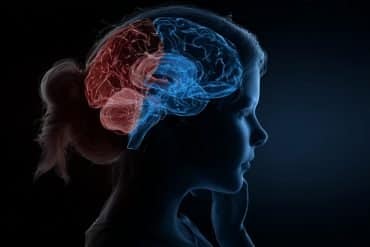Summary: Researchers reveal how brain structure and chemistry give rise to specific aspects of fluid intelligence.
Source: University of Illinois.
A new study begins to clarify how brain structure and chemistry give rise to specific aspects of “fluid intelligence,” the ability to adapt to new situations and solve problems one has never encountered before.
The study, reported in the journal NeuroImage, links higher concentrations of a marker of energy production in the brain with an improved ability to solve verbal and spatial problems. It also finds an association between brain size and number-related problem-solving.
The analysis involved 211 research subjects, making it the largest study to date linking brain chemistry and intelligence in living humans, said University of Illinois postdoctoral researcher Erick Paul, who led the work with research scientist Ryan Larsen and Illinois neuroscience professor Aron Barbey. The work was conducted in the Decision Neuroscience Laboratory at the Beckman Institute for Advanced Science and Technology. More studies will be needed to confirm and extend the findings, the researchers said.
“In our data, we observed two facets of fluid intelligence – one that involves quantitative or numeric reasoning, and another that involves verbal or spatial reasoning,” Paul said. “A similar separation of reasoning abilities has been demonstrated in previous studies.”
The researchers conducted magnetic resonance spectroscopy to analyze brain concentrations of a compound called NAA (N-acetyl aspartate), a byproduct of glucose metabolism and a marker of energy production. They measured brain volume in all subjects using magnetic resonance imaging.
“We found that the quantitative reasoning component of intelligence correlated with brain volume, but not with the concentration of NAA in the brain,” Paul said. “And the verbal and spatial components of intelligence correlated with NAA, but not with brain volume.”

The team observed the same basic relationships when analyzing males and females separately.
The findings add to the evidence that fluid intelligence involves distinct yet interrelated processes in the brain, Paul said.
“Surely there are many things about the brain that determine a person’s intelligence, and the goal is to try to tease apart that puzzle,” he said. “These two brain biomarkers, brain volume and NAA, are each giving us independent information about fluid intelligence. There are different properties of the brain that we can measure, and these different properties go with these different facets of fluid intelligence.”

“Our findings contribute to a growing body of evidence to suggest that intelligence reflects multiple levels of organization in the brain – spanning neuroanatomy, for example brain size, and neurophysiology, such as brain metabolism – and that specific properties of the brain provide a powerful lens to investigate and understand the nature of specific intellectual abilities,” Barbey said.
Aron Barbey is a faculty member in the department of psychology, an affiliate of the Beckman Institute and of the Carl R. Woese Institute for Genomic Biology.
Funding: The Intelligence Advanced Research Projects Activity at the Office of the Director of National Intelligence supported this research.
Source: Diana Yates – University of Illinois
Image Source: This NeuroscienceNews.com images are credited to Julie McMahon, Ryan Larsen and Erick Paul
Original Research: Full open access research for “Dissociable brain biomarkers of fluid intelligence” by Erick J. Paul, Ryan J. Larsen, Aki Nikolaidis, Nathan Ward, Charles H. Hillman, Neal J. Cohen, Arthur F. Kramer, and Aron K. Barbey in NeuroImage. Published online May 14 2016 doi:10.1016/j.neuroimage.2016.05.037
[cbtabs][cbtab title=”MLA”]University of Illinois. “Brain Markers For Numeric, Verbal and Spatial Reasoning Abilities Discovered.” NeuroscienceNews. NeuroscienceNews, 20 June 2016.
<https://neurosciencenews.com/verbal-numeric-spatial-reasoning-4514/>.[/cbtab][cbtab title=”University of Illinois”]University of Illinois. (2016, June 20). Brain Markers For Numeric, Verbal and Spatial Reasoning Abilities Discovered. NeuroscienceNews. Retrieved June 20, 2016 from https://neurosciencenews.com/verbal-numeric-spatial-reasoning-4514/[/cbtab][cbtab title=”Chicago”]University of Illinois. “Brain Markers For Numeric, Verbal and Spatial Reasoning Abilities Discovered.” https://neurosciencenews.com/verbal-numeric-spatial-reasoning-4514/ (accessed June 20, 2016).[/cbtab][/cbtabs]
Abstract
Dissociable brain biomarkers of fluid intelligence
Cognitive neuroscience has long sought to understand the biological foundations of human intelligence. Decades of research have revealed that general intelligence is correlated with two brain-based biomarkers: the concentration of the brain biochemical N-acetyl aspartate (NAA) measured by proton magnetic resonance spectroscopy (MRS) and total brain volume measured using structural MR imaging (MRI). However, the relative contribution of these biomarkers in predicting performance on core facets of human intelligence remains to be well characterized. In the present study, we sought to elucidate the role of NAA and brain volume in predicting fluid intelligence (Gf). Three canonical tests of Gf (BOMAT, Number Series, and Letter Sets) and three working memory tasks (Reading, Rotation, and Symmetry span tasks) were administered to a large sample of healthy adults (n = 211). We conducted exploratory factor analysis to investigate the factor structure underlying Gf independent from working memory and observed two Gf components (verbal/spatial and quantitative reasoning) and one working memory component. Our findings revealed a dissociation between two brain biomarkers of Gf (controlling for age and sex): NAA concentration correlated with verbal/spatial reasoning, whereas brain volume correlated with quantitative reasoning and working memory. A follow-up analysis revealed that this pattern of findings is observed for males and females when analyzed separately. Our results provide novel evidence that distinct brain biomarkers are associated with specific facets of human intelligence, demonstrating that NAA and brain volume are independent predictors of verbal/spatial and quantitative facets of Gf.
“Dissociable brain biomarkers of fluid intelligence” by Erick J. Paul, Ryan J. Larsen, Aki Nikolaidis, Nathan Ward, Charles H. Hillman, Neal J. Cohen, Arthur F. Kramer, and Aron K. Barbey in NeuroImage. Published online May 14 2016 doi:10.1016/j.neuroimage.2016.05.037






